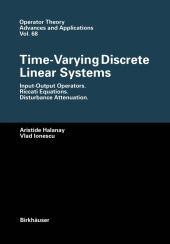 Neuerscheinungen 2012Stand: 2020-01-07 |
Schnellsuche
ISBN/Stichwort/Autor
|
Herderstraße 10
10625 Berlin
Tel.: 030 315 714 16
Fax 030 315 714 14
info@buchspektrum.de |

Aristide Halanay, Vlad Ionescu
(Beteiligte)
Time-Varying Discrete Linear Systems
Input-Output Operators. Riccati Equations. Disturbance Attenuation
Softcover reprint of the original 1st ed. 1994. 2012. x, 230 S. X, 230 p. 244 mm
Verlag/Jahr: SPRINGER, BASEL; BIRKHÄUSER BASEL 2012
ISBN: 3-03-489651-4 (3034896514)
Neue ISBN: 978-3-03-489651-1 (9783034896511)
Preis und Lieferzeit: Bitte klicken
Discrete-time systems arise as a matter of course in modelling biological or economic processes. For systems and control theory they are of major importance, particularly in connection with digital control applications. If sampling is performed in order to control periodic processes, almost periodic systems are obtained. This is a strong motivation to investigate the discrete-time systems with time-varying coefficients. This research monograph contains a study of discrete-time nodes, the discrete counterpart of the theory elaborated by Bart, Gohberg and Kaashoek for the continuous case, discrete-time Lyapunov and Riccati equations, discrete-time Hamiltonian systems in connection with input-output operators and associated Hankel and Toeplitz operators. All these tools aim to solve the problems of stabilization and attenuation of disturbances in the framework of H2- and H-control theory. The book is the first of its kind to be devoted to these topics and consists mainly of original, recently obtained results.
0. General motivation.- 1. Evolutions and related basic notions.- 2. Nodes.- 3. Riccati equations and nodes.- 4. Disturbance Attenuation.- Appendix A. Discrete-time stochastic control.- 1. Discrete-time Riccati equation of stochastic control.- 2. Optimal compensator under independent random disturbances.- Notes and References.- Appendix B. Almost periodic discrete-time systems.- 1. Standeard theory of almost periodic sequences.- 2. A new Bochner theory for almost periodic sequences.- 3. Almost periodic evolution.- 4. Evolutions under Besicovitch sequences.- Notes and References.- References.


